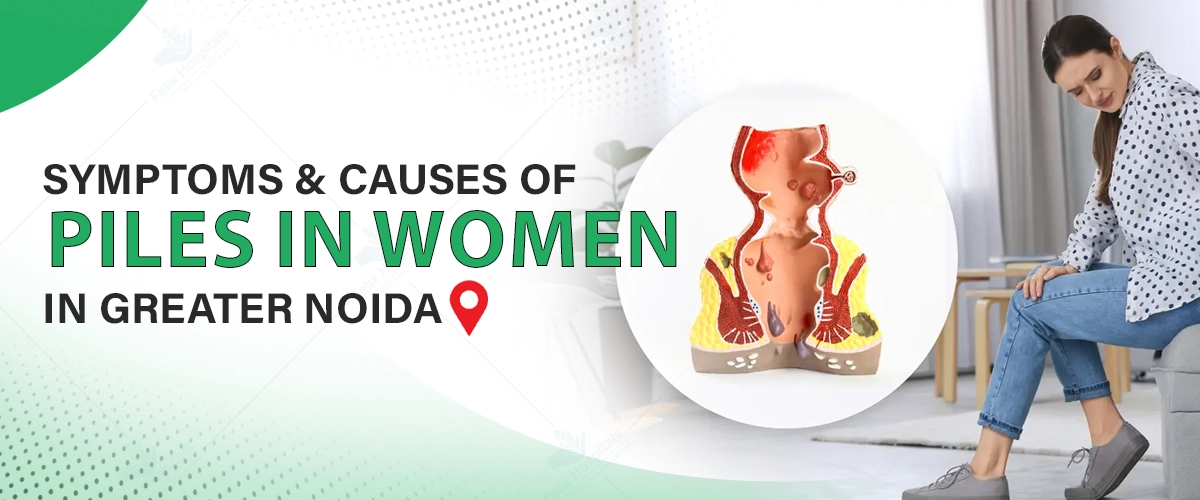
Subscribe to our

Piles, or hemorrhoids, are inflammed and swollen veins in the lower rectum and anus. Though present in both men and women, piles are not widely discussed among women, although they are more prone to it due to pregnancy, childbirth, and hormonal variation.
About 40% of Indian adults are estimated to have developed piles in their lifetime, as per recent estimates. The effect can be even greater for women. Early detection of the symptoms and treatment can prevent complications and enhance the quality of life. In the event of chronic symptoms, visiting the best laparoscopic Hospital in Greater Noida provides proper and secure treatment.
At Felix Hospitals, we offer thorough assessment and advanced treatments for the treatment of piles in women. Book your appointment now at +91 9667064100.
Piles occur when the veins in the anus or rectum become distended due to increased pressure or straining. In women, piles can result in pain, itching, or bleeding, especially during or after a bowel movement. The risk of developing piles is higher during hormonal fluctuations, pregnancy, and when straining during delivery.
Piles can be of two types based on their location and severity:
1. Internal Piles
2. External Piles
At Felix Hospitals, the top hospital in Greater Noida, the expert specialists treat you based on the grade and type of piles.
Symptoms are not the same, yet some of them are:
Pregnancy, constipation, and prolonged sitting can aggravate these symptoms.
Various reasons raise the likelihood of piles in women:
Consult experts at the top hospital in Greater Noida before attempting home remedies to get the right diagnosis and safe management.
Diagnosis of piles includes the following steps:
The treatment depends upon the type of piles (internal or external), their grade (from I to IV), and the severity of symptoms.
Adopting these suggestions in daily life can significantly reduce the risk of piles. Consult a specialist for permanent relief from frequent symptoms or repeated problems.
The cost of treating piles in Greater Noida is determined by a number of medical and non-medical factors. Knowing them may assist patients in planning better and preventing any financial surprises.
Make an appointment now at +91 9667064100 and embark on the path of permanent relief and improved well-being.
Piles in women should never be ignored. From hormonal changes and pregnancy to poor diet and sedentary lifestyle, several factors can contribute to the development of piles. Felix Hospitals serves the best treatment with the best doctors in Greater Noida, providing gentle care with the most modern facilities designed for your issue. Whether you’re experiencing discomfort or suspecting early signs, don’t delay.
Q: Do piles get worse after delivery?
Ans: Yes, piles can worsen due to the repeated straining that occurs during delivery. If they continue 2–3 weeks after delivery, consult a specialist.
Q: Do hormonal cycles or contraceptives cause piles?
Ans: Yes, hormonal changes cause stretching of vein walls, thus predisposing them to trouble during menstruation or with the use of hormonal contraceptives.
Q: What should one eat post-piles surgery?
Ans: Take a high-fiber diet of soft foods after piles surgery to allow bowel movements and healing. Consume fruits, cooked vegetables, whole cereals, and plenty of water. Do not take spicy, oily, or processed foods during the initial period of recovery.
Q: Who surgically removes piles?
Ans: A general surgeon or a proctologist normally diagnoses and performs surgery to remove piles.
Q: Is it okay to live with piles?
Ans: Whereas mild piles can be dealt with by changing lifestyle and medications, chronic or unattended piles can result in pain, bleeding, and discomfort. It is recommended that one see a doctor in case the symptoms increase or continue.
Q: Can I sit after piles surgery?
Ans: Yes, but sitting will hurt for a few days. It is best to sit on a soft pillow or a donut pillow and not sit for more than a short time. Gentle exercises and short walks are recommended to permit circulation and healing.
Q: What types of pile sizes require surgery?
Ans: Grade III and Grade IV piles—the ones that prolapse but do not spontaneously retract—usually need surgery. Piles that are small (Grade I or II) can be treated conservatively if they are symptomatic.